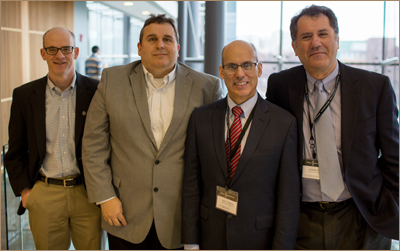
(BOSTON) – Nearly 75 physicians, R&D scientists and biomedical engineers gathered on March 27, 2015, to attend the Wyss Institute’s inaugural Annual Diabetes Symposium. The one-day event was held to promote better understanding of the unmet management needs of Diabetic Lower Extremity (DLE) complications and to discuss the latest innovative therapeutic approaches currently under development.
People who have diabetes can suffer from several foot and lower extremity health issues as a result of their diabetic condition. Every year in the United States, more than 750,000 new foot ulcers and 70,000 lower limb amputations occur as a result of DLE complications.
High blood glucose can harden the arteries and capillaries, reducing blood flow to the feet, and can also result in nerve damage. Not only can nerve damage be painful, it can also cause sufferers to lose their ability to feel pain, heat and cold. Small injuries such as blisters or cuts can go unnoticed, causing them to fester and become infected. Nerves controlling oil and skin moisture stop working which only adds to risk of infection by causing dry, cracking skin. Ulcers can develop which can lead to loss of limbs if not treated immediately.
The symposium participants reviewed the health challenges that result from diabetic neuropathic damage and reduced blood supply, discussed ongoing developments in research that can impact DLE management, explored new therapeutic approaches and identified key opportunities for collaboration between academia and industry.

Several experts in the field of biomedical engineering gave presentations including MIT Professor of Polymer Science and Engineering Ioannis Yannas, Ph.D., who was inducted into the National Inventors Hall of Fame in February 2015 for inventing an artificial skin, and Boston University Professor of Dermatology and Biochemistry Vincent Falanga, M.D., FACP, who is recognized for novel stem cell therapies developed for wound healing and tissue repair.
The keynote, “DNA-based Building Blocks for Future Therapeutics” delivered by Wyss Core Faculty member William Shih, Ph.D., discussed how DNA can be used as a construction material for nanoscale therapeutic devices. Shih is developing strategies for using DNA building blocks to to deliver drugs to precise targets or to trigger biological mechanisms at specific locations in the body, which could be leveraged to address infections and conditions that result from DLE complications.
The symposium also welcomed a number of poster submissions from which one was selected as a winner in terms of most innovative approach addressing the biology, management and treatment of DLE, including potential new therapeutic strategies. The winning poster, “Diabetes primes neutrophils to undergo NETosis which severely impairs wound healing”, describes findings that indicate a new therapeutic strategy could improve diabetic wound healing by mitigating the effect diabetes has on the body’s anti-microbial defenses.
Next year’s Annual Diabetes Symposium is being planned for Spring 2016.